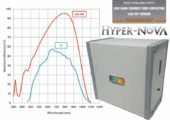Raman scattering is an inelastic scattering process that can be used to probe vibrational energy levels. All molecules can vibrate in various ways, but it takes energy to do so. Vibrations have energy levels, just like electrons do. To make molecules vibrate, a molecule has to absorb a photon with the same energy as the difference between vibrational energy levels. This energy is usually in the IR range. IR spectroscopy is a type of absorption spectroscopy that probes vibrations. Raman scattering is an indirect way of probing vibrations. Instead of the light source being in the IR, the light source is in the visible or NIR, which means it is higher in energy. When the visible or near-infrared photons interact with the molecules, they scatter in all directions, but they lose a bit of energy in the process. This energy is the same amount of energy used to get to a higher vibrational energy levels.
Introducing our new Applied Spectroscopy Division
New Handheld Raman!
New! ChemWiz-ADK Handheld NIR Spectrophotometer with on board chemometrics and spectral matching!
Read More
Check out our SpectroChemistry Systems for UV-VIS and Fluorescence Applications
Learn More
New Spectrometer Python Application Driver
for Windows, Linux, RasPi, Mac
Check it out!
HYPER-Nova Highest Performance Raman Spectrometer
Learn More





